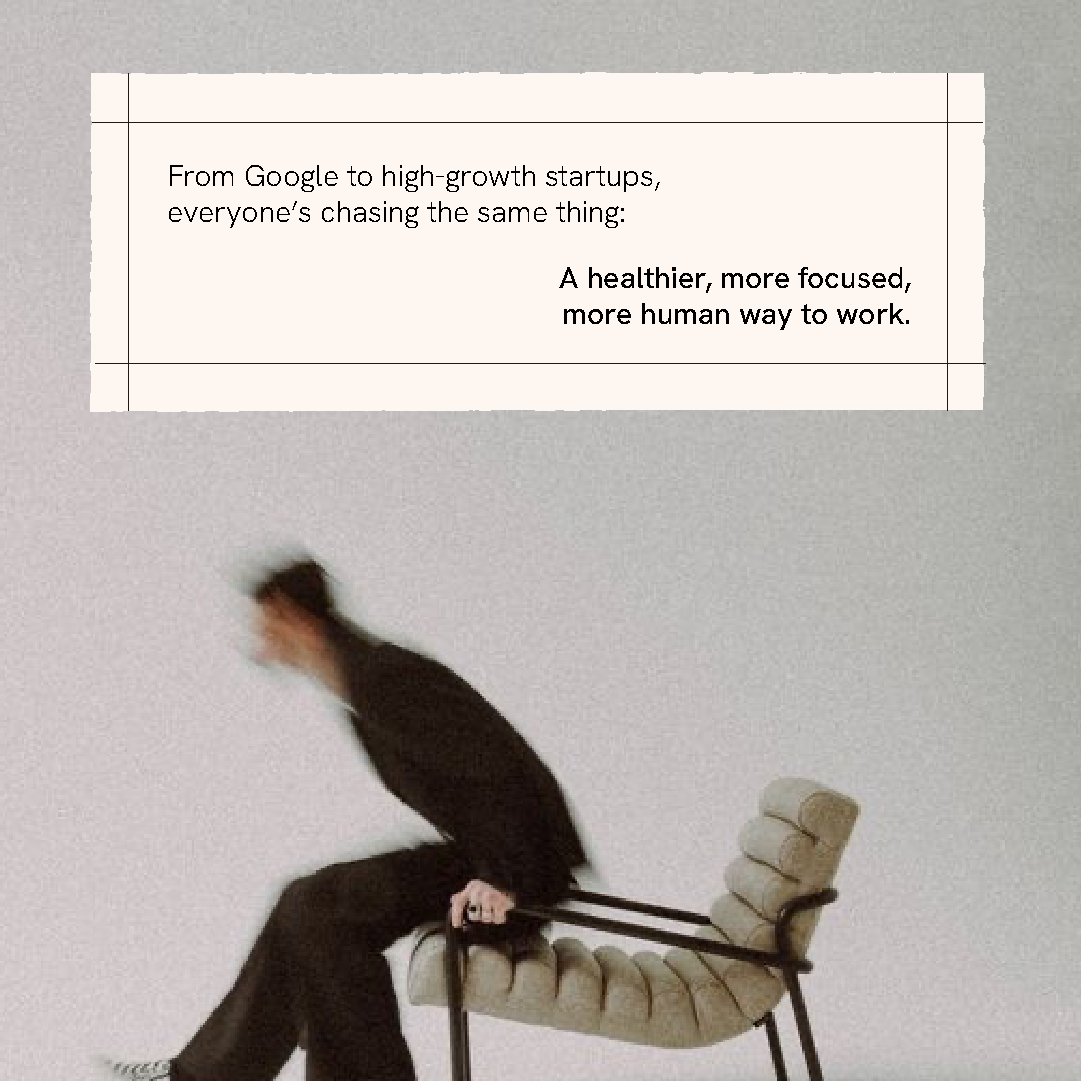As the founder of away.center, I’ve seen firsthand how a little movement can spark big changes. We live in a world where back-to-back meetings and screen time often crowd out physical activity, but it's time to reclaim movement as a secret weapon for both health and professional success. Did you know nearly one third of adults worldwide, about 1.8 billion people, aren’t getting enough exercise?who.int This isn’t just a wellness issue; it's a productivity crisis in disguise. In this post, I’ll share why incorporating physical exercise into your routine isn’t a distraction from work – it’s a powerful investment in your health, focus, and career. Let’s dive into the science, benefits, and practical ways to get moving (even on busy workdays), all backed by recent research and a vision for the future of work.
Physical Activity: The Ultimate Brain Boost
We often hear that doing exercise is good for the body, but it’s just as vital for the mind. In fact, physical activity acts like a fertilizer for your brain – sharpening cognition, lifting your mood, and reducing stress. According to the CDC, exercise can immediately improve brain function. Even a single moderate workout triggers benefits like sharper thinking in kids and less anxiety in adultscdc.gov. And those short-term boosts might last longer than we thought. A 2024 study reported in Harvard Health found that any amount of moderate-to-vigorous exercise was linked to better memory and cognition on the next dayhealth.harvard.edu. Participants who got moving (like a brisk walk or some dancing) scored higher on memory tests the following day, showing that today’s workout can make you mentally sharper at tomorrow’s meetingshealth.harvard.edu.

Why does this happen? Exercise literally feeds your brain – increasing blood flow and releasing neurotransmitters like norepinephrine and dopamine that enhance learning and focus health.harvard.edu. Neuroscientists are excited by findings that these neurochemical changes, once thought to fade after a couple of hours, can actually last much longer health.harvard.edu. No wonder many of us feel that post-exercise mental clarity and creative spark! And creativity, it turns out, also gets a lift from staying active. In one study, people who were more physically active scored higher on creativity tests – pointing to a real link between physical activity and imagination in everyday life ciphr.com.
Let’s not forget mood and mental health. We’re all juggling high-stress jobs, and exercise is one of the best stress-busters on the planet. When you move, your body releases serotonin and endorphins – natural mood lifters that counteract stress hormones. Healthy exercise habits can reduce feelings of anxiety and depression over time cdc.gov. Wendy Suzuki, a professor of neural science, explains that exercise actually replenishes the very neurotransmitters that stress depletes, helping you feel more resilient and focused under pressure ciphr.com. In simpler terms: a workout can calm your nerves and reset your mood on a tough day. If you have a big project that demands intense focus, a bit of exercise beforehand might be the best prep – it improves your ability to shift and sustain attention, so you can dive into deep work with a primed brain ciphr.com. And as a bonus, exercise literally helps your brain grow: it stimulates the birth of new brain cells in the hippocampus, boosting memory and learning capacity ciphr.com. All this should serve as strong motivation to get moving when your brain needs a boost.
Physical Fitness: Building a Healthy, Resilient Body
Beyond the brain, physical fitness is the bedrock of long-term health – and a healthy body is the foundation for sustained high performance at work. The research here is crystal clear: regular physical exercise profoundly improves your physical well-being. For starters, it protects your heart and circulatory system. Getting at least 150 minutes of moderate exercise a week (that’s about 30 minutes a day, five days a week) can lower your risk of heart disease and stroke, the leading causes of death cdc.gov. It also helps keep blood pressure and cholesterol in checkcdc.gov. Over time, an active lifestyle drastically cuts the risk of type 2 diabetes and metabolic issues as wellcdc.gov.
Staying active even boosts your immune system and resilience. We saw this vividly during the pandemic: people who were inactive were much more likely to suffer severe outcomes from illnesses like COVID-19 than those who exercised regularlycdc.gov. On the flip side, physical activity strengthens your body’s defenses – active individuals had about half the risk of dying from flu or pneumonia compared to inactive folks in one studycdc.gov. Your body simply handles health challenges better when it’s fit.
Perhaps the most eye-opening stat is how even small amounts of activity add up to longer life. Researchers estimate that adding just 10 minutes of brisk physical activity per day could prevent roughly 110,000 deaths per year in the U.S.cdc.gov. Ten minutes! That’s the length of a coffee break. It underscores that you don’t need to be an Olympic athlete; even modest activity can be a life-extending, healthy exercise. On a day-to-day level, staying fit means more energy (instead of that 3pm slump, you have the stamina to cruise through the workday) and better sleep at night. The CDC notes that physically active people not only feel and function better during the day, they also sleep better at nightcdc.govcdc.gov – and we all know a good night’s sleep is rocket fuel for productivity the next morning.
An often overlooked benefit of building physical fitness is resilience against burnout. When you’re strong and healthy, you’re more resistant to the toll of long hours and high pressure. Exercise teaches your body to recover faster – whether it’s from a tough workout or a tough week at work. In the corporate world, where marathon work weeks are common, treating your body well is not a luxury; it’s a strategy for sustainable success. Think of each workout or active break as maintenance for the most important piece of equipment you have – yourself. As I often remind my team, you can’t pour from an empty cup. Physical activity keeps refilling that cup, so you can bring energy and enthusiasm to your mission every day.
Physical Activity and Productivity: The Business Case
If you’re a leader or entrepreneur, here’s the bottom line: encouraging movement isn’t just about employee wellness – it’s about your organization’s performance. Time and again, studies show that an active workforce is a more productive workforce. Physically active employees tend to have lower healthcare costs, fewer sick days, and higher on-the-job productivitypublichealth.jhu.edu. They’re literally at work more and feeling better when they’re there. For example, research has found that employees who get even a modest amount of vigorous exercise (about 75 minutes a week) miss 4.1 fewer work days per year on averagepublichealth.jhu.edu. That’s four extra days of productivity gained simply by keeping active. Fewer sick days and doctor visits also mean lower healthcare expenditures for companies – one analysis attributed over 11% of total healthcare spending to physical inactivity, a cost that could be trimmed with a more active populationpublichealth.jhu.edu. It’s clear that investing in wellness pays off in hard numbers.
But the productivity boost from exercise isn’t just about not getting sick; it’s about coming to work energized and mentally dialed in. In one eye-opening 10-day study by researchers (reported in Harvard Business Review), about 200 employees tracked their activity and work performance. The findings were striking: on days after people were physically active, they came to work with more “resources” – better mood, higher vigor (i.e. energy), improved focus, and even better sleep from the night beforeciphr.com. Essentially, exercise created a “resource caravan” for the next day, giving employees more fuel in the tank to tackle their tasks. Participants even reported higher job self-efficacy – basically a boost in confidence that “I’ve got this” when facing work challengesciphr.com. That confidence and positivity translate into real performance gains. Interestingly, the researchers noted a slight delay in benefits, meaning your Monday workout might show its full effects in your Tuesday productivity – a useful insight as you plan your routineciphr.com. The takeaway: exercise today, crush it at work tomorrow.
We also have evidence that structured wellness programs make a measurable difference. In one University of California study, workers were given access to a wellness program with personalized health coaching (encouraging better diet and exercise). The result? Those who improved their health through diet and physical exercise saw about a 10% increase in their productivity at workciphr.com. Imagine the impact on your bottom line if your whole team became 10% more productive – those are the kinds of gains no smart leader would ignore. Additionally, companies often see lower absenteeism when they promote fitness. It’s not just theory: some groups of employees who were allowed to spend a few hours of work time on exercise actually accomplished more overall while also taking fewer sick leaves, essentially proving that well-being and output go hand in hand.
And yes, even the feeling of productivity is higher when you’re active. A recent survey by Velotric found that people who exercised in the morning were 129% more likely to feel productive during their workdaycharitydigital.org.uk. Many top executives swear by their morning workouts for exactly this reason – it injects energy and momentum into the day. (While morning exercise isn’t the only way, it certainly seems to set a positive tone.) From the C-suite to entry-level, when you’re physically active, you tend to have more mental clarity, stamina, and motivation at work. As one famous biologist put it, “physical activity is like cognitive candy”ciphr.com – it feeds our brains and bodies what they need to perform optimally.
In short, physical activity isn’t a cost to your productivity; it’s a catalyst for it. Forward-thinking companies understand this. They’re creating cultures that celebrate movement – whether it’s walking meetings, in-office gyms, or flexible schedules that allow for exercise – because they know it leads to more creative, productive, and engaged employees. The business case is compelling: when you move more, you achieve more.
Integrating Movement into Your Workday
Okay, we’ve covered the why – now let’s talk about the how. It’s one thing to know that exercise is good for you (and your work), but quite another to fit it into a jam-packed schedule. The good news is you don’t have to overhaul your life or become a marathon runner to reap the benefits. Small, consistent steps can add up. Remember that statistic about 10 extra minutes of exercise a day preventing thousands of deaths? It highlights a key point: every bit of movement countscdc.gov.
If you’re a busy professional, here are some practical ways to integrate physical activity into your daily work life:
- Micro-breaks with motion: Instead of scrolling your phone for five minutes, try a quick burst of activity. Do some light stretches at your desk, walk a couple of laps around the office, or climb a few flights of stairs. Even short doing exercise breaks can refresh your mind and get your blood flowing. Many people find that a 5-minute movement break every hour or two actually improves their focus for the next task, rather than interrupting their work.
- Active commutes and errands: If you live close enough, consider walking or cycling to work (even partway). Or park a bit farther than usual and walk the rest. If you take public transit, get off one stop early. These are sneaky ways to get more steps in without carving out extra time. Over a week, those steps and stairs really add up to improve your physical fitness.
- Walking meetings: Need to talk through ideas or have a one-on-one check-in? Take it on the move. Walking meetings are a fantastic way to blend work and exercise. The change of scenery can spur creativity, and as a bonus, you return to the office having gotten some activity in. (Some of the best brainstorming sessions at away.center have happened while walking outside together.)
- Desk ergonomics and stretch routines: If you’re in long meetings or deep-focus blocks, practice some simple desk exercises. Shoulder rolls, neck stretches, or even standing up and sitting down a few times (squat practice!) can prevent stiffness. Better yet, use a standing desk for part of the day if you have one – standing uses more muscles than sitting and helps you avoid the “post-lunch slump.” Make it a habit to stand or stretch whenever you’re on a phone call or when you finish a task.
- Schedule active time like a meeting: We’re all more likely to do something if it’s on our calendar. So, block out a slot for your physical exercise just as you would for an important meeting. It could be a 30-minute jog in the morning, a lunchtime gym class, or an after-work bike ride – whatever fits your style. Treat that appointment with yourself as non-negotiable. If you truly can’t spare 30 minutes in one go, break it into three 10-minute sessions throughout the day. Research shows that these short bouts of exercise still offer real benefits.
- Leverage technology and social support: Use fitness tracker apps or smartwatch reminders to nudge you to move. Sometimes a simple ping to “stand up and move” is enough to break you out of a sedentary trance. You can also start a step challenge or join a virtual exercise group with colleagues or friends for accountability. At away.center, we have a Slack channel where team members share their daily workout or step count – it’s a fun way to motivate each other and celebrate progress (plus a little friendly competition!).
The key is to weave movement into your routine in ways that feel natural and enjoyable. If you love nature, maybe a walk in a park is your midday recharge. If you miss your sports days, a pickup basketball game or a quick tennis match might be your ticket. Find what healthy exercise fits your life and make it a habit. Remember, consistency beats intensity. It’s better to take a 15-minute walk every day than to hit the gym for two hours once a month and burn out. Over time, these small changes become a lifestyle. You’ll notice you have more energy, your mood is brighter, and work tasks don’t feel as draining. By integrating physical activity into your workday, you’re not taking time away from work – you’re investing it into making your work time more effective.
And for those of us in leadership roles: encourage your team to move, too! Be the example and also give permission. Something as simple as suggesting a team stretch break or sponsoring employee fitness classes can create a culture where movement is welcomed. The future of work is wellness-forward. By building an active, energized workforce, we prepare our organizations to thrive in the long run.
Conclusion: Lead with Movement, Succeed with Wellness
In the hustle of modern business, it’s easy to dismiss exercise as a “nice to have” or something to cram in on weekends. But as we’ve explored, physical activity is a powerful engine for both personal health and peak work performance. When you prioritize movement, you’re not just doing something good for yourself off the clock – you’re actively enhancing your creativity, productivity, and resilience on the clock. Think of it as a secret superpower that the most successful leaders and professionals are already tapping into. (There’s a reason many top CEOs start their day with exercise – they know it gives them an edge in clarity and energy.)
My challenge to you is simple: start where you can. Take that first walk around the block, stretch when you feel tension, schedule one or two active breaks in your calendar this week. Protect that time. Treat it as essential, because it is. Over time, those small acts of self-care through movement will snowball into big gains. You’ll likely find you’re not only feeling healthier – you’re making sharper decisions, handling stress better, and perhaps even inspiring your colleagues to follow suit.
At away.center, our vision is a future where work and wellness go hand in hand. I truly believe the companies that embrace this mindset will surge ahead – with teams that are not just working, but thriving. The science backs it and experience proves it: when we power our bodies, we power our careers. So let’s lead the way by lacing up our sneakers, stepping away from the desk, and returning with renewed vigor and purpose. Your health, your team, and your bottom line will all be better for it.
.png)
Now, get moving – your next great idea might be just a brisk walk away.
FAQs:
Physical Activity, Health, and Productivity
Q1: I’m already so busy – how can I find time for physical exercise during the workweek?
A: Finding time for exercise in a busy schedule is definitely a challenge, but it’s doable with small tweaks. Start by integrating short activity bursts into your day. For example, use 10 minutes of your lunch break for a walk, or do a quick stretch routine in the morning before you dive into emails. You can also combine activities: try a walking meeting or take the stairs instead of the elevator to sneak in extra movement. Remember, you don’t need a huge time block to benefit – even several 5- or 10-minute bouts of exercise scattered through the day add up. Treat those active minutes like important appointments. By scheduling them (and even putting them on your calendar), you’re more likely to stick with it. Over time, these little pockets of physical activity become a habit, and you’ll wonder how you managed without them.
Q2: Won’t taking breaks for exercise make me less productive at work?
A: It may seem counterintuitive, but taking short breaks to move can boost your productivity rather than hurt it. When you exercise, you recharge your brain – increasing blood flow and oxygen delivery, which helps you concentrate better afterward. Ever notice how a quick walk can clear a mental fog? That’s the effect in action. Research actually shows that employees who incorporate activity into their day often get more done in the long runciphr.comcharitydigital.org.uk. Plus, exercise breaks can prevent the fatigue that comes from sitting too long. The key is to keep breaks short and purposeful. A 15-minute workout or a stretch won’t derail your schedule; instead, it will likely leave you more energized and focused for the next task. Think of exercise not as lost time, but as an investment in a sharper, more efficient you.
Q3: Is it true that exercising in the morning is better for work performance?
A: Morning workouts work great for many people, but the “best” time to exercise is the time you can stick with consistently. That said, exercising in the morning can have some unique advantages. It primes you for the day – you’ll start work feeling awake, accomplished, and full of energy after a good sweat. One survey even found morning exercisers feel significantly more productive (they were 129% more likely to report being productive at work)charitydigital.org.uk. Morning exercise can also improve your mood and focus for hours afterward, acting like a natural caffeine boost. However, if your mornings are too hectic, don’t force it. Lunchtime or evening workouts are perfectly fine too. Some people prefer a late afternoon run to de-stress after work. The bottom line: any exercise, no matter the time of day, is better than none. Choose a time that fits your schedule and energy rhythms. Consistency is what delivers results.
Q4: What kind of physical activity is best for improving health and productivity?
A: There’s no one-size-fits-all answer – the best exercise is the one you enjoy enough to do regularly. Different types of physical activities offer different benefits, and a mix is ideal. Aerobic exercises (cardio) like brisk walking, running, cycling, or swimming are fantastic for heart health, brain function, and mood. These get your heart rate up and have been linked to improved memory and thinking skillshealth.harvard.edu. Strength training (like weightlifting or bodyweight exercises) is great for building muscle, improving posture, and preventing injuries – a strong body handles daily work stress better and can alleviate aches from desk work. Activities like yoga or Pilates improve flexibility and reduce stress, which can help with the mental clarity you bring to work. Even simple stretching or short healthy exercise routines can make a difference. Ideally, aim for a combination: cardio for endurance and brain boost, strength training for physical resilience, and stretching for mobility. But if that sounds overwhelming, start with what appeals to you most. Whether it's dancing, a sport, or walking your dog, any activity that gets you moving consistently will yield health and productivity benefits.
Q5: I haven’t exercised in years and I’m not in great shape. How can I start a healthy exercise routine without overdoing it?
A: First of all, congratulations on deciding to get back into it – that’s the hardest step! The key is to start low and slow. You want to build a healthy exercise routine that is sustainable and safe. Begin with gentle activities like walking or beginner-friendly workouts. Even 10 minutes of light exercise is a good starting point. As your fitness improves, you can gradually increase the duration or intensity. Listen to your body – a little muscle soreness is normal when starting out, but sharp pain is a red flag to ease up. It might be helpful to set modest goals, like “walk 3 days a week for 15 minutes,” and then celebrate when you hit them. Consistency is more important than intensity at the beginning. If you have any specific health concerns or conditions, consider talking to a doctor or a fitness professional to tailor a plan that suits you. Remember, every bit of movement counts. What matters is that you’re doing exercise regularly, even if it’s gentle. Over time, your strength and confidence will grow. Before you know it, you’ll be looking forward to those workouts as a highlight of your day. Stay patient and enjoy the journey – you’re doing something wonderful for your body and mind!
ถุน (Keep moving and stay healthy!)
.svg)
.png)





